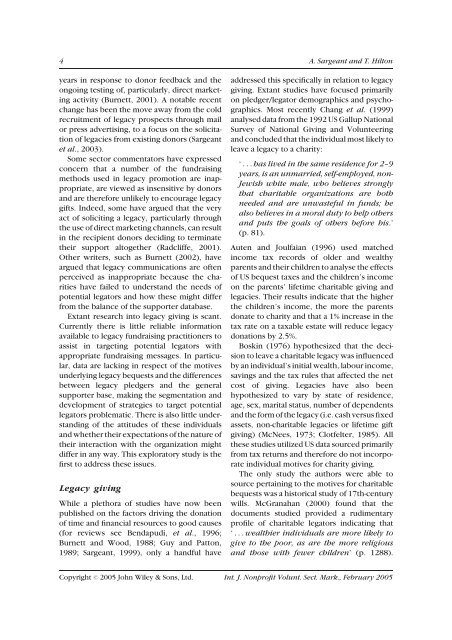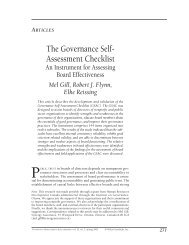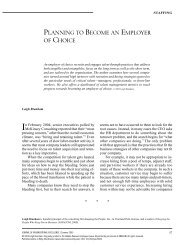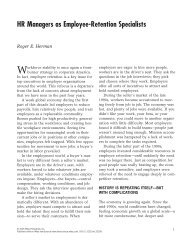The final gift: targeting the potential charity legator
The final gift: targeting the potential charity legator
The final gift: targeting the potential charity legator
You also want an ePaper? Increase the reach of your titles
YUMPU automatically turns print PDFs into web optimized ePapers that Google loves.
4 A. Sargeant and T. Hilton<br />
years in response to donor feedback and <strong>the</strong><br />
ongoing testing of, particularly, direct marketing<br />
activity (Burnett, 2001). A notable recent<br />
change has been <strong>the</strong> move away from <strong>the</strong> cold<br />
recruitment of legacy prospects through mail<br />
or press advertising, to a focus on <strong>the</strong> solicitation<br />
of legacies from existing donors (Sargeant<br />
et al., 2003).<br />
Some sector commentators have expressed<br />
concern that a number of <strong>the</strong> fundraising<br />
methods used in legacy promotion are inappropriate,<br />
are viewed as insensitive by donors<br />
and are <strong>the</strong>refore unlikely to encourage legacy<br />
<strong>gift</strong>s. Indeed, some have argued that <strong>the</strong> very<br />
act of soliciting a legacy, particularly through<br />
<strong>the</strong> use of direct marketing channels, can result<br />
in <strong>the</strong> recipient donors deciding to terminate<br />
<strong>the</strong>ir support altoge<strong>the</strong>r (Radcliffe, 2001).<br />
O<strong>the</strong>r writers, such as Burnett (2002), have<br />
argued that legacy communications are often<br />
perceived as inappropriate because <strong>the</strong> charities<br />
have failed to understand <strong>the</strong> needs of<br />
<strong>potential</strong> <strong>legator</strong>s and how <strong>the</strong>se might differ<br />
from <strong>the</strong> balance of <strong>the</strong> supporter database.<br />
Extant research into legacy giving is scant.<br />
Currently <strong>the</strong>re is little reliable information<br />
available to legacy fundraising practitioners to<br />
assist in <strong>targeting</strong> <strong>potential</strong> <strong>legator</strong>s with<br />
appropriate fundraising messages. In particular,<br />
data are lacking in respect of <strong>the</strong> motives<br />
underlying legacy bequests and <strong>the</strong> differences<br />
between legacy pledgers and <strong>the</strong> general<br />
supporter base, making <strong>the</strong> segmentation and<br />
development of strategies to target <strong>potential</strong><br />
<strong>legator</strong>s problematic. <strong>The</strong>re is also little understanding<br />
of <strong>the</strong> attitudes of <strong>the</strong>se individuals<br />
and whe<strong>the</strong>r <strong>the</strong>ir expectations of <strong>the</strong> nature of<br />
<strong>the</strong>ir interaction with <strong>the</strong> organization might<br />
differ in any way. This exploratory study is <strong>the</strong><br />
first to address <strong>the</strong>se issues.<br />
Legacy giving<br />
While a plethora of studies have now been<br />
published on <strong>the</strong> factors driving <strong>the</strong> donation<br />
of time and financial resources to good causes<br />
(for reviews see Bendapudi, et al., 1996;<br />
Burnett and Wood, 1988; Guy and Patton,<br />
1989; Sargeant, 1999), only a handful have<br />
addressed this specifically in relation to legacy<br />
giving. Extant studies have focused primarily<br />
on pledger/<strong>legator</strong> demographics and psychographics.<br />
Most recently Chang et al. (1999)<br />
analysed data from <strong>the</strong> 1992 US Gallup National<br />
Survey of National Giving and Volunteering<br />
and concluded that <strong>the</strong> individual most likely to<br />
leave a legacy to a <strong>charity</strong>:<br />
‘ ...has lived in <strong>the</strong> same residence for 2–9<br />
years, is an unmarried, self-employed, non-<br />
Jewish white male, who believes strongly<br />
that charitable organizations are both<br />
needed and are unwasteful in funds; he<br />
also believes in a moral duty to help o<strong>the</strong>rs<br />
and puts <strong>the</strong> goals of o<strong>the</strong>rs before his.’<br />
(p. 81).<br />
Auten and Joulfaian (1996) used matched<br />
income tax records of older and wealthy<br />
parents and <strong>the</strong>ir children to analyse <strong>the</strong> effects<br />
of US bequest taxes and <strong>the</strong> children’s income<br />
on <strong>the</strong> parents’ lifetime charitable giving and<br />
legacies. <strong>The</strong>ir results indicate that <strong>the</strong> higher<br />
<strong>the</strong> children’s income, <strong>the</strong> more <strong>the</strong> parents<br />
donate to <strong>charity</strong> and that a 1% increase in <strong>the</strong><br />
tax rate on a taxable estate will reduce legacy<br />
donations by 2.5%.<br />
Boskin (1976) hypo<strong>the</strong>sized that <strong>the</strong> decision<br />
to leave a charitable legacy was influenced<br />
by an individual’s initial wealth, labour income,<br />
savings and <strong>the</strong> tax rules that affected <strong>the</strong> net<br />
cost of giving. Legacies have also been<br />
hypo<strong>the</strong>sized to vary by state of residence,<br />
age, sex, marital status, number of dependents<br />
and <strong>the</strong> form of <strong>the</strong> legacy (i.e. cash versus fixed<br />
assets, non-charitable legacies or lifetime <strong>gift</strong><br />
giving) (McNees, 1973; Clotfelter, 1985). All<br />
<strong>the</strong>se studies utilized US data sourced primarily<br />
from tax returns and <strong>the</strong>refore do not incorporate<br />
individual motives for <strong>charity</strong> giving.<br />
<strong>The</strong> only study <strong>the</strong> authors were able to<br />
source pertaining to <strong>the</strong> motives for charitable<br />
bequests was a historical study of 17th-century<br />
wills. McGranahan (2000) found that <strong>the</strong><br />
documents studied provided a rudimentary<br />
profile of charitable <strong>legator</strong>s indicating that<br />
‘ ...wealthier individuals are more likely to<br />
give to <strong>the</strong> poor, as are <strong>the</strong> more religious<br />
and those with fewer children’ (p. 1288).<br />
Copyright # 2005 John Wiley & Sons, Ltd. Int. J. Nonprofit Volunt. Sect. Mark., February 2005







